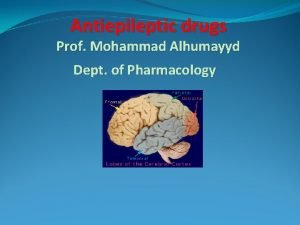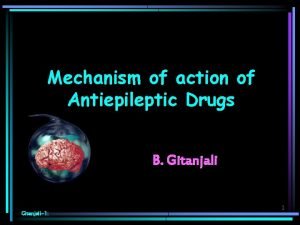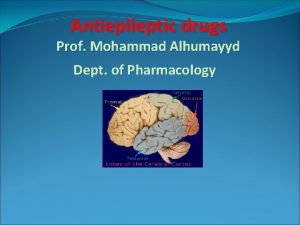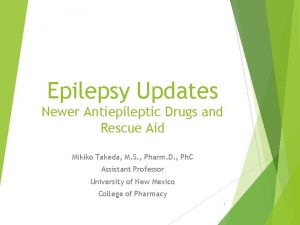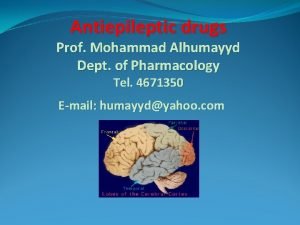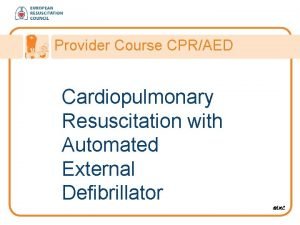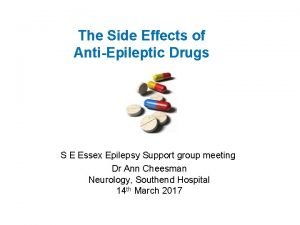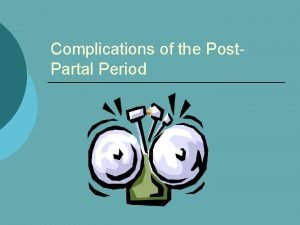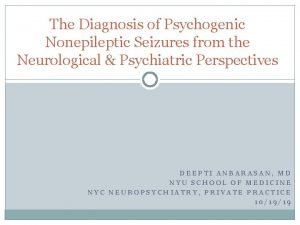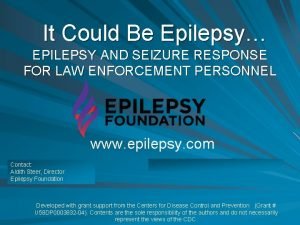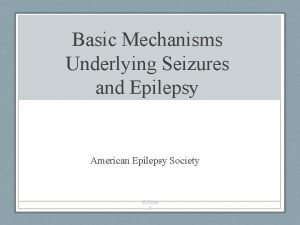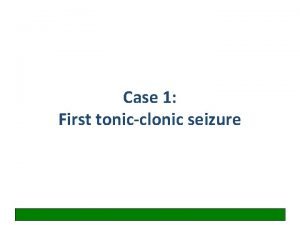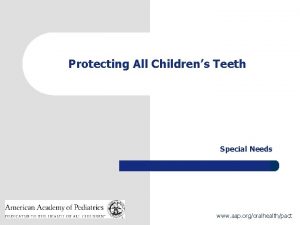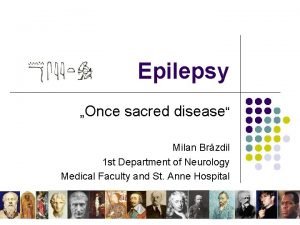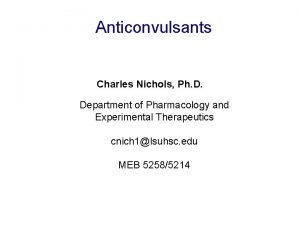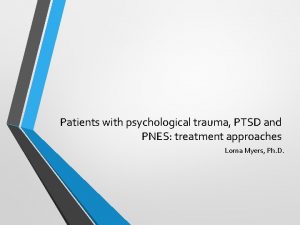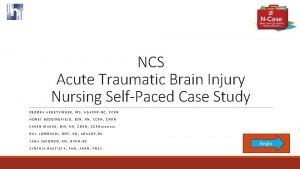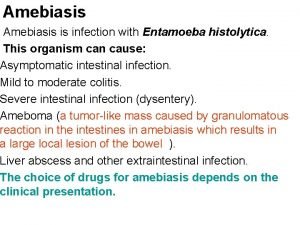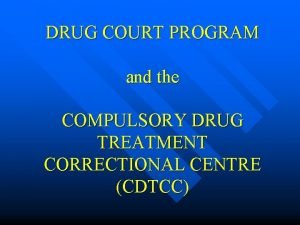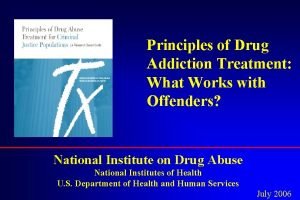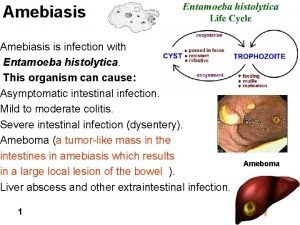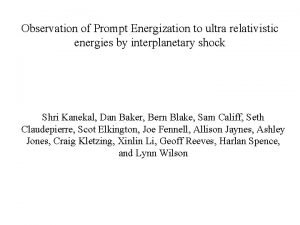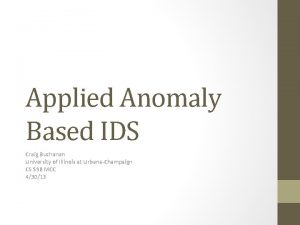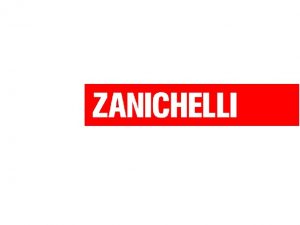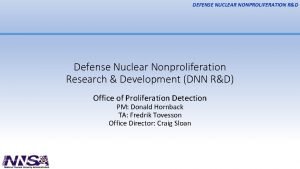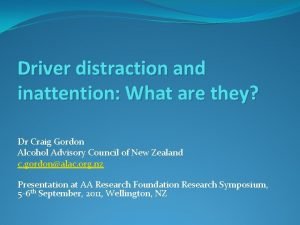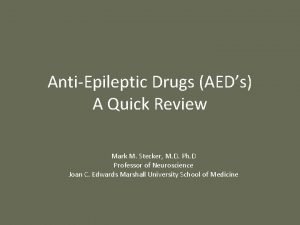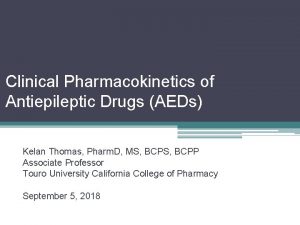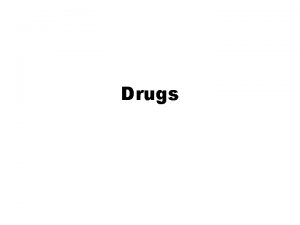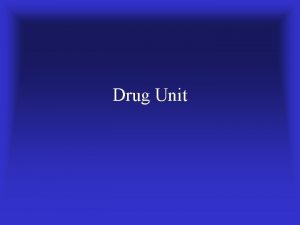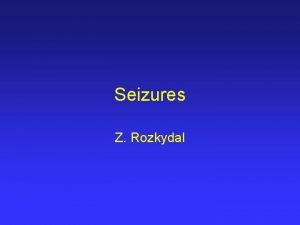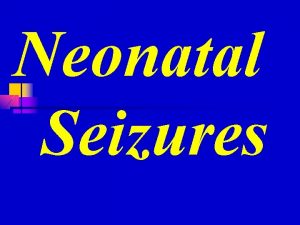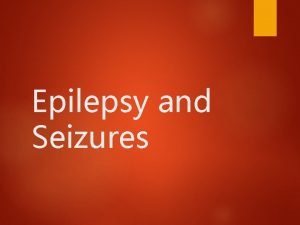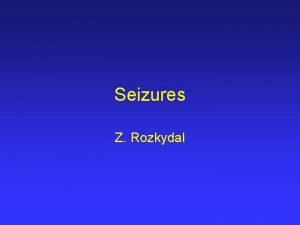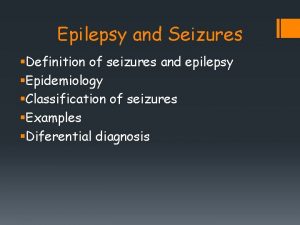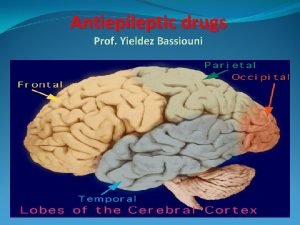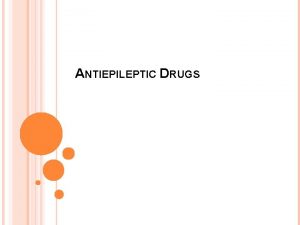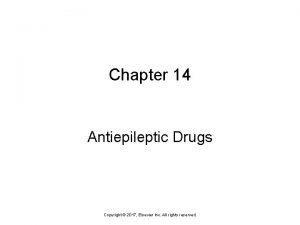Drug Treatment of Seizures Antiepileptic Drugs AEDs Craig


















































- Slides: 50

Drug Treatment of Seizures: Antiepileptic Drugs (AEDs) Craig Watson, M. D. , Ph. D. Professor of Neurology Wayne State University School of Medicine Founding Director, WSU/DMC Comprehensive Epilepsy Program




Which AEDs to Use: Partial Seizures w/wo GTCS Drugs of choice l l CBZ PHT Newer AEDs l l l Second line AEDs l l l VPA PB PRM l l LTG TPM OXC LEV ZNS PGB LCM Second line AEDs l l GBP TGB


Which AEDs to Use: Primary Generalized Epilepsy Drugs of choice l Simple absence (CAE) VPA l ESM l l GTCS VPA l CBZ l PHT l l Mixed PGE l VPA Newer AEDs l l LTG TPM LEV ZNS










Established AEDs

Phenytoin (PHT) l Indications: SPS, CPS, w/wo 2 ary GTCS. Primary GTCS. Add-on & monotherapy. l Side Effects: Usual AED AEs (+ gum hyperplasia, hirsutism). Idiosyncratic reactions. l Mechanism of Action: Sodium channel blocker. Decrease sustained high-frequency neuronal firing. l Pharmacokinetics: t 1/2=24 hours. Metabolized in liver. Nonlinear kinetics. 90% protein bound. l Drug Interactions: Decrease CBZ, PB, LTG, TPM, TGB levels. Displaces VPA, ? CBZ from albumin, increasing free levels. l Dosing: Q day. Begin with full maintenance dose. Ultimate dose variable & based on serum drug level and response.

Carbamazepine (CBZ) l Indications: SPS, CPS, w/wo 2 ary GTCS. Primary GTCS. Add-on & monotherapy. l Side Effects: Usual AED AEs (+ diplopia, leukopenia, hyponatremia). Idiosyncratic reactions. SJS/TEN in Asians with HLA-B* 1502. l Mechanism of Action: Sodium channel blocker. Decrease sustained high-frequency neuronal firing. l Pharmacokinetics: t 1/2=12 hours. Metabolized in liver. Autoinduction. Active epoxide metabolite (CBZE). 75% protein bound. l Drug Interactions: Decrease CBZ, PHT, PB, LTG, TPM, TGB levels. Mildly displaces VPA, PHT from albumin, increasing free levels. l Dosing: BID-QID. Begin with 200 mg BID & increase slowly to ultimate dose based on serum drug level and response.

Valproate (VPA) l Indications: Primary generalized epilepsy. SPS, CPS, w/wo 2 ary GTCS. Add-on & monotherapy. l Side Effects: Weight gain, tremor, alopecia, GI upset. Idiosyncratic liver failure & pancreatitis. l Mechanism of Action: Enhances GABA effects. Sodium channel blocker. Decrease sustained high-frequency neuronal firing. Reduce lowthreshold T-calcium channel currents. Others. l Pharmacokinetics: t 1/2=12 hours. Metabolized in liver. Inhibits liver enzymes. Active metabolites. 90% protein bound. l Drug Interactions: Displaces PHT, ? CBZ from albumin, increasing free levels. Increases LTG levels. Mildly decreases TPM levels. l Dosing: BID-QID. Begin with 15 mg/kg/day. Increase slowly to ultimate dose based on serum drug level and response (30 -60 mg/day).

Phenobarbital (PB) l Indications: SPS, CPS, w/wo 2 ary GTCS. Primary GTCS. Add-on & monotherapy. l Side Effects: Usual AED AEs (+ sedation, paradoxical activation in children). Idiosyncratic reactions. l Mechanism of Action: Prolong GABA-mediated chloride channel openings. Decrease CNS excitation. l Pharmacokinetics: t 1/2=48 -118 hours (mean=72 hours). Metabolized in liver. 25 -50% excreted unchanged in urine. 50% protein bound. l l Drug Interactions: Decrease CBZ, PHT, LTG, TPM, TGB levels. Dosing: Q day. Begin with full maintenance dose. Ultimate dose based on serum drug level and response.

Primidone (PRM) l Indications: SPS, CPS, w/wo 2 ary GTCS. Primary GTCS. Add-on & monotherapy. l l Side Effects: Usual AED AEs (+ sedation). Idiosyncratic reactions. Mechanism of Action: Prolong GABA-mediated chloride channel openings. Decrease CNS excitation. l Pharmacokinetics: t 1/2=12 hours. Metabolized in liver. 50% protein bound. l l Drug Interactions: Decrease CBZ, PHT, LTG, TPM, TGB levels. Dosing: BID-QID. Begin with 250 mg BID & increase slowly to ultimate dose based on serum drug level and response.

Ethosuximide (ESM) l Indications: Primary generalized epilepsy (especially simple absence seizures). Add-on & monotherapy. l l Side Effects: Usual AED AEs (+ GI upset). Idiosyncratic reactions. Mechanism of Action: Reduce low-threshold T-calcium channel currents. Disrupt slow rhythmic firing of thalamic neurons. l Pharmacokinetics: t 1/2=12 hours. Metabolized in liver. 0% protein bound. l l Drug Interactions: None significant. Dosing: BID-QID. Begin with 250 mg BID & increase slowly to ultimate dose based on serum drug level and response. Optimal dose for children=20 mg/kg/day.

New AEDs

Felbamate (FBM) l Indications: SPS, CPS, w/wo 2 ary GTCS. ? ? PGE. Lennox-Gastaut syndrome (LGS). Add-on & monotherapy. l Side Effects: Activation, anorexia, weight loss, insomnia. Idiosyncratic liver failure & aplastic anemia. l Mechanism of Action: Glutamate & GABA effects. Sodium & calcium channel blocker. l Pharmacokinetics: t 1/2=24 hours. 50% metabolized in liver. Competes with other AEDs for liver enzymes. 25% protein bound. l Drug Interactions: Decrease CBZT. Increase CBZE (50%), PHT (2550%), VPA (25 -50%) levels. l Dosing: BID-TID. Begin with 600 mg BID & increase slowly to ultimate dose based on side effects and response. Usual dose=1200 -3600 mg/day.

Gabapentin (GBP) l l l Indications: SPS, CPS, w/wo 2 ary GTCS. Add-on therapy. Side Effects: Usual AED AEs. Mechanism of Action: Binds to α 2 -δ subunit of voltage-gated calcium channels and modulates calcium currents; thereby decreasing excitatory neurotransmitter (glutamate, NE, substance P) release. l Pharmacokinetics: t 1/2=5 -7 hours. Not metabolized in liver. Excreted in urine. Minimal protein binding. Nonlinear: Decreased absorption at higher doses. l l Drug Interactions: None. Dosing: TID-QID. Begin with 300 mg TID & increase slowly to ultimate dose based on side effects and response. Usual dose=1200 -3600 (4800) mg/day.

Lamotrigine (LTG) l Indications: SPS, CPS, w/wo 2 ary GTCS. PGE (GTCS). LGS. Add-on & monotherapy. l l Side Effects: Usual AED AEs (+ rash, especially with VPA). Mechanism of Action: Inhibits voltage-sensitive sodium channels & modulates presynaptic release of glutamate. Calcium channel blocker. l Pharmacokinetics: t 1/2=12 hours (EIAED), 24 hours (mono. Rx, EIAED + VPA), 48 hours (VPA). Metabolized in liver. 55% protein bound. l Drug Interactions: LTG does not affect other AED levels. EIAEDs decrease LTG (40%). VPA increases LTG (200%). l Dosing: BID. VPA: 25 mg QOD x 2 wks. , 25 mg/d x 2 wks. , slowly increase to 100 -150 mg/day. No VPA: 50 mg/d x 2 wks. , 100 mg/d x 2 wks. , slowly increase to ultimate dose based on side effects and response. Usual dose=300 -700 mg/day.

Topiramate (TPM) l Indications: SPS, CPS, w/wo 2 ary GTCS. PGE (GTCS). LGS. Add-on & monotherapy. l Side Effects: Usual AED AEs (+ psychomotor slowing, speech difficulties, renal stones, paresthesias, angle-closure glaucoma). l Mechanism of Action: Unknown. Perhaps sodium channel blocker, GABA receptor activation, AMPA receptor antagonist, calcium channel inhibition. Weak carbonic anhydrase inhibitor (increase fluid intake). l Pharmacokinetics: t 1/2=20 -30 hours (No EIAEDs). t 1/2=12 -15 hours (EIAEDs). Low (30 -50%) liver metabolism. Excreted in urine. 15% protein bound. l Drug Interactions: TPM does not affect other AED levels (occasional increase in PHT level). EIAEDs decrease TPM (40%). l Dosing: BID. Begin with 25 mg/d & increase slowly to ultimate dose based on side effects and response. Usual dose=100 -400 mg/day.

Tiagabine (TGB) l l Indications: SPS, CPS, w/wo 2 ary GTCS. Add-on therapy. Side Effects: Usual AED AEs (+ fatigue, nervousness, tremor, depression, aphasia, weakness). l Mechanism of Action: Blocks reuptake of GABA into presynaptic neuron & glia, thereby extending GABA effects on postsynaptic neuron. l Pharmacokinetics: t 1/2=4 -7 hours (EIAEDs), 7 -9 hours (noninduced). Metabolized in liver (cytochrome P 450 system). 90% protein bound. l Drug Interactions: TGB does not affect other AED levels. EIAEDs decrease TGB levels. l Dosing: BID-QID. Begin with 4 -8 mg/d & increase slowly by 4 -8 mg/wk to ultimate dose based on side effects and response. Usual dose=32 -56 mg/day.

Oxcarbazepine (OXC) l l l Indications: SPS, CPS, w/wo 2 ary GTCS. Add-on & monotherapy. Side Effects: Usual AED AEs (+ diplopia, hyponatremia). Mechanism of Action: Sodium channel blocker. Decrease sustained high-frequency neuronal firing. Also, increased potassium conductance & modulation of some calcium channels. l Pharmacokinetics: t 1/2=2 hours (OXC), 9 hours (MHD). Metabolized in liver (not by cytochrome P 450) to active metabolite (MHD). Excreted in urine. 40% protein bound. l Drug Interactions: OXC does not affect other AED levels (except increase PHT by 40% at higher doses). EIAEDs decrease OXC (25 -40%). l Dosing: BID. Begin with 300 mg BID & increase by 600 mg/wk to ultimate dose based on side effects and response. Usual dose=1200 -2400 mg/day.

Levetiracetam (LEV) l Indications: SPS, CPS, w/wo 2 ary GTCS. PGE (Myoclonic seizures in JME, GTCS). Add-on therapy. l l Side Effects: Usual AED AEs. Mechanism of Action: Unknown. Perhaps N-type calcium channel blocker, enhances GABAA inhibition, decreases excitation by blocking potassium rectifier current, prevents hypersynchronization of burst firing & seizure propagation in HF. Binds to synaptic vesicle protein 2 A (SV 2 A). l Pharmacokinetics: t 1/2=6 -8 hours. Not metabolized in liver. Excreted in urine. <10% protein bound. l l Drug Interactions: None. Dosing: BID. Begin with 500 mg BID & increase by 500 mg/wk to ultimate dose based on side effects and response. Usual dose=1000 -3000 mg/day.

Zonisamide (ZNS) l l l Indications: SPS, CPS, w/wo 2 ary GTCS. ? ? PGE, PME. Add-on therapy. Side Effects: Usual AED AEs (+ psychomotor slowing, speech difficulties, renal stones, paresthesias, anorexia, agitation, headache). Idiosyncratic hypersensitivity reactions to sulfonamides (rash, hepatic necrosis, leukopenia, aplastic anemia, blood dyscrasias). Mechanism of Action: Unknown. Perhaps sodium channel blocker, reduce low-threshold T-calcium currents, facilitates dopaminergic/serotonergic transmission. Weak carbonic anhydrase inhibitor (increase fluid consumption). Pharmacokinetics: t 1/2=63 hours (plasma), 105 hours (RBCs). Metabolized in liver (cytochrome P 450 system). Excreted in urine. 40% protein bound. Drug Interactions: ZNS does not affect other AED levels. EIAEDs decrease ZNS levels. Dosing: Q day-BID. Begin with 100 mg/d & increase by 100 mg Q 2 wks to ultimate dose based on side effects and response. Usual dose=100 -400 (600) mg/day.

Pregabalin (PGB) l l l Indications: SPS, CPS, w/wo 2 ary GTCS. Add-on therapy. Side Effects: Usual AED AEs. Mechanism of Action: Binds to α 2 -δ subunit of voltage-gated calcium channels and modulates calcium currents; thereby decreasing excitatory neurotransmitter (glutamate, NE, substance P) release. l Pharmacokinetics: t 1/2=6 hours (pharmacodynamic t 1/2 is longer). Not metabolized in liver. Excreted in urine. No protein binding. l l Drug Interactions: None. Dosing: BID-TID. Begin with 150 mg/day & increase slowly to ultimate dose based on side effects and response. Usual dose=150 -600 mg/day.

Lacosamide (LCM) l l Indications: SPS, CPS, w/wo 2 ary GTCS. Add-on therapy. Side Effects: Usual AED AEs (dizziness, headache, diplopia, sedation, ataxia, diminished coordination, nystagmus, nausea, vomiting). Small increase in median PR interval (5 -9 msec) on EKG. l Mechanism of Action: Unknown. Enhances slow inactivation of sodium channels (stabilizes hyperexcitable neurons, inhibits repetitive neuronal firing). Binds to collapsin response mediator protein (CRMP-2). l Pharmacokinetics: t 1/2=13 hours. Metabolized in liver (CYP 2 C 19) to an inactive metabolite. Excreted in urine. <15% protein bound. l Drug Interactions: LCM does not significantly affect other AED levels. EIAEDs decrease LCM (15 -20%). l Dosing: BID. Begin with 50 mg/day & increase slowly to ultimate dose based on side effects and response. Usual dose=200 -400 mg/day.

Vigabatrin (VGB) l l l Indications: Refractory SPS, CPS, w/wo 2 ary GTCS. Add-on therapy (Adults). Infantile spasms in children. Monotherapy. Side Effects: Usual AED AEs (dizziness, fatigue, sedation, tremor, blurred vision, arthralgia). (Also, anemia, weight gain, edema, neuropathy). Progressive, permanent visual field constriction in >30% of patients. Mechanism of Action: Irreversible inhibitor of GABA transaminase (GABA-T), thereby increasing GABA levels in the CNS. Pharmacokinetics: t 1/2=7. 5 hours (duration of drug effect dependent on GABA-T resynthesis). Not metabolized in liver. Excreted in urine. No protein binding. Drug Interactions: None, except for a slight decrease in total PHT level Dosing: BID. Begin with 500 mg BID & increase by 500 mg/wk to ultimate dose based on side effects and response. Usual dose=1000 -3000 mg/day.











Zaccara G, et al. Epilepsia 2007; 48: 1223 -1244

Zaccara G, et al. Epilepsia 2007; 48: 1223 -1244

Zaccara G, et al. Epilepsia 2007; 48: 1223 -1244

Topiramate (TPM): Angle-closure glaucoma Occurs more often in females. Younger age than in the usual patient with glaucoma. l Occurs within 3 weeks of initiation of TPM treatment l Occurs at low doses (50 -150 mg/d) l Symptoms: Acute blurred vision (due to acute myopia), pain, and redness in both eyes l Caused by choroid and ciliary body swelling which “pushes” the angle of the anterior chamber closed l Stopping TPM is the only effective treatment l

 Phenytoin mechanism of action
Phenytoin mechanism of action Ethosuximide mechanism of action
Ethosuximide mechanism of action Mechanism of action of antiepileptic drugs
Mechanism of action of antiepileptic drugs Antiepileptic drugs abbreviation
Antiepileptic drugs abbreviation Antiepileptic drug classification
Antiepileptic drug classification Cpr cycle for adults
Cpr cycle for adults Antiepileptic side effects
Antiepileptic side effects Antiepileptic side effects
Antiepileptic side effects What does infected lochia look like
What does infected lochia look like Different methods of adulteration of crude drugs
Different methods of adulteration of crude drugs Simple partial seizures vs complex
Simple partial seizures vs complex Tonic-clonic seizures
Tonic-clonic seizures Non epileptic seizures
Non epileptic seizures What to do if someone is having a seizure
What to do if someone is having a seizure Psychomotor seizures
Psychomotor seizures Basic mechanisms underlying seizures and epilepsy
Basic mechanisms underlying seizures and epilepsy Seizures
Seizures Pediatric seizures
Pediatric seizures Complex febrile seizure
Complex febrile seizure Psychomotor seizures
Psychomotor seizures Pimidone
Pimidone Lorna myers pnes
Lorna myers pnes Simple partial seizures vs complex
Simple partial seizures vs complex Abdominal ultrasound scan glasgow
Abdominal ultrasound scan glasgow Difference between seizure and epilepsy
Difference between seizure and epilepsy Tremors and seizures
Tremors and seizures Drug of choice for the treatment of extraluminal amebiasis
Drug of choice for the treatment of extraluminal amebiasis Cdtcc
Cdtcc Neurosurgery
Neurosurgery Principles of drug addiction treatment
Principles of drug addiction treatment Drug of choice for the treatment of extraluminal amebiasis
Drug of choice for the treatment of extraluminal amebiasis Why ibm fully homomorphic encryption
Why ibm fully homomorphic encryption Buried penis
Buried penis Craig kletzing
Craig kletzing Fedmall login
Fedmall login Craig gentry
Craig gentry Craig nicolson
Craig nicolson Ids craig
Ids craig Craig watson md phd
Craig watson md phd Wildcad craig
Wildcad craig Craig heller
Craig heller Craig sloan nnsa
Craig sloan nnsa Craig redford
Craig redford Climograph of toronto
Climograph of toronto Craig mulcahy
Craig mulcahy Jitasol
Jitasol Daniel craig homeless
Daniel craig homeless Dr craig gordon
Dr craig gordon Craig dilger
Craig dilger Craig hamlet
Craig hamlet Professor craig jackson
Professor craig jackson
